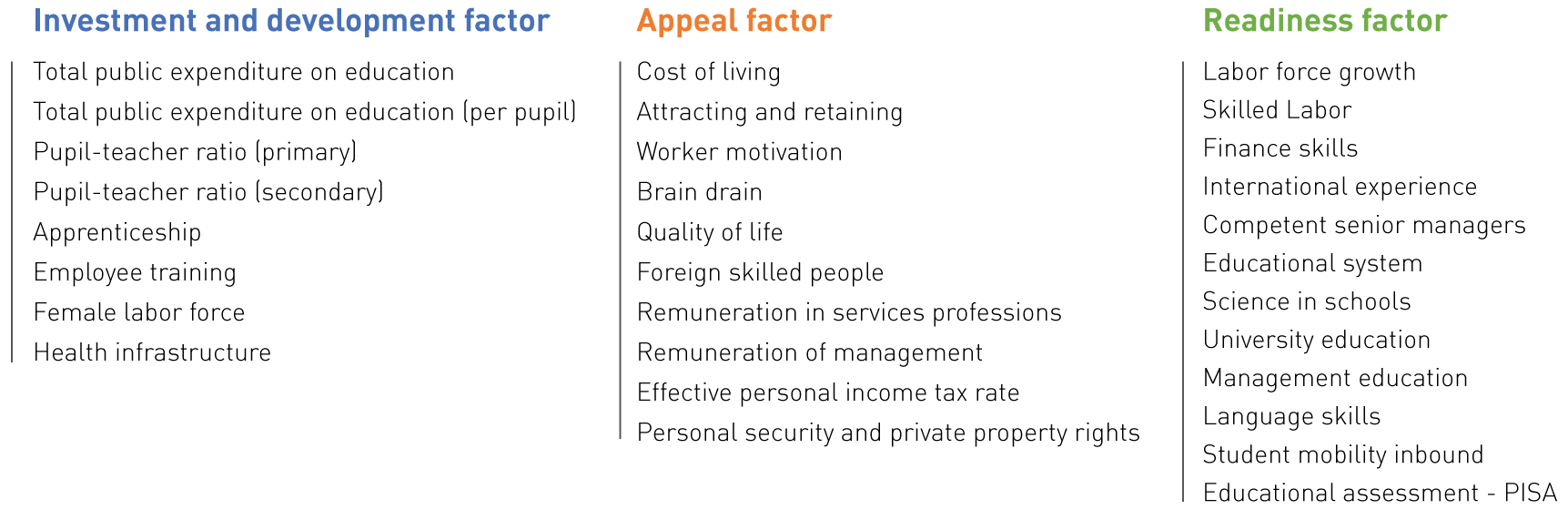
Talent competitiveness and leadership quality
Public policies can strongly influence the quality of leadership capabilities and competencies available in a particular country. For example, policies that increase education expenditure, personal security and workforce internationalization may determine the supply of high quality business leaders. To assess what public policies might have the greatest impact on high quality leadership, we performed a series of tests to identify which talent competitiveness indicators from the IMD World Talent Report have a significant influence on the components of IMD’s Global Leader Index (GLI).
Talent competitiveness
Talent is the set of individual competencies necessary for enterprises and the economy to achieve long-term sustainable value. There are two components to talent: 1) “hard” competencies, which are structural and function as enablers of development – for example, investment in the educational system; and 2) “soft” competencies, which are in a sense the outcome of hard competencies and include language skills. These factors go beyond a mere increase in investment and include other elements that boost, for example, the motivation and productivity of the workforce through suitable incentives. Talent competitiveness is thus the extent to which an economy strikes a balance between hard and soft talent components, which enables it to achieve long-term value creation. IMD’s talent competitiveness structure – which includes both “hard” and “soft” competences – is presented in Table 1. (Find out more about the methodology).

Table 1: Talent competitiveness
Global leadership
The GLI assesses individual global leadership capabilities. It is composed of four leadership capabilities or factors: Strategic, execution, stakeholder and personal. Strategic leadership evaluates the capacity of leaders to define strategic objectives. Execution leadership is the ability to implement the organization’s strategy to achieve specific objectives. Stakeholder leadership refers to the capacity of individuals to engage other relevant players to achieve organizational changes. Finally, personal leadership focuses on individual characteristics that allow leaders, for example, to inspire others. Each of these capabilities is composed of four competencies that were developed through survey questions that evaluate respondents’ leadership practices. Table 2 introduces the GLI structure.

Table 2: Global leadership
Talent competitiveness and leadership quality
Global leadership capabilities
At the GLI capability level, we found evidence that highly skilled talent is attracted by the diversity level in the receiving communities. An increasing percentage of the female labor force (a proxy for workforce diversity) partially drives two leadership capabilities: strategic and stakeholder leadership. Strategic leadership is also highly influenced by total public expenditure on education, the quality of healthcare, the prioritization of talent attraction and retention, and remuneration. In addition, strategic leadership is also driven by three indicators of internationalization: availability of internationally experienced senior managers, language skills and student mobility. Other drivers of stakeholder leadership are expenditure on education, remuneration, language skills, student mobility, and high personal security and protection of private property. Evidence highlights the fundamental role of expenditure on education for the other two leadership capabilities – execution and personal leadership. Other drivers of personal leadership capabilities include personal security and private property protection, and student mobility.
Global leadership competencies
At the GLI competence level, the driving innovation competency includes the ability to encourage finding innovative solutions. Evidence shows that this competency is driven by a greater female labor force, remuneration, student mobility and strong educational achievements (as assessed by PISA). We find that the quality of a country’s health infrastructure is significant for communicating and implementing a company’s vision and strategy. There is also evidence that the cost of living, a limited brain drain and an effective tax system contribute to the clarity and execution of the vision and strategy. International mobility also drives this competency. The mobilizing stakeholders competency is driven by expenditure on education, the percentage of female labor force and language skills. In addition, the effectiveness of the health infrastructure, remuneration, an effective personal income tax rate and student mobility are statistically significant for stakeholder mobilization. Evidence suggests that the percentage of female labor force is also significant for empowering others (e.g., delegation of authority to increase others’ efficiency). Attractiveness of the country for foreign highly skilled people and management remuneration also drive this competency. Finally, we find that exposure to internationalization (i.e., student mobility) and educational achievements are also fundamental for the empowering people sub-factor.
Conclusions
Our study showed that the essential drivers of leadership are indicators related to diversity and internationalization. Evidence suggests that greater female labor force leads to the attraction and/or development of high quality leadership. In addition, our results highlight the positive leadership synergies resulting from the workforce exposure to international experience, language skills and mobility factors (i.e., proxies for internationalization). The latter is a source of global knowledge, broader experience and wider set of best practices. Our tests also show that investment in education and the country’s health infrastructure positively affect the quality of the available business leadership. Compensation levels are important but seem to play a less important role than investment in education, diversity and internationalization.
Overall, the evidence shows that the impact of talent competitiveness on high quality leadership results from achieving a degree of harmonization between “hard” elements of talent (e.g., investment in education) and some of their “soft” counterparts (e.g., language skills). Public policies that ensure alignment between both sets of talent components contribute greatly to an economy’s competitiveness.
Read more about the recently released IMD World Talent Report.
Arturo Bris is Professor of Finance at IMD and directs the IMD World Competitiveness Center.
Christos Cabolis is Chief Economist with the IMD World Competitiveness Center
José Caballero is Senior Economist with the IMD World Competitiveness Center.
Research Information & Knowledge Hub for additional information on IMD publications
The B case outlines how, by early 2025, Isabella Phoenix's initial vision for HP's Amplify Impact sustainability program had grown into a global initiative involving 4,800 partners in 48 countries. The program surpassed its goals, enrolling 59 of ...
The A case in this two-part series outlines the challenges Isabella Phoenix faced in designing a global sustainability program for HP's vast network of channel partners in just 12 weeks with only one team member and limited resources. The initiati...
Les études de cas de HBR sont basées sur des problèmes vécus par des dirigeants d’entreprise et proposent des solutions d’experts. Celle-ci est tirée de l’étude de cas de l’Insead « Stress and the City (A&B) : Antonio Horta-Osorio, CEO of Lloyds B...
When the leaders of the Brics group of developing countries gather on Sunday for their 17th annual summit, the backdrop is one of the most geopolitically volatile the bloc has faced in years, with trade tension, regional conflicts and energy insta...
When Chinese Premier Li Qiang addressed the World Economic Forum’s “Summer Davos” in Tianjin, China, his message was clear: China must become a “mega-sized” consumption powerhouse. Not just the world’s factory, but its market too. His words underl...
Research Information & Knowledge Hub for additional information on IMD publications
Case reference: IMD-2681 ©2025
Research Information & Knowledge Hub for additional information on IMD publications
Research Information & Knowledge Hub for additional information on IMD publications
Research Information & Knowledge Hub for additional information on IMD publications
in I by IMD Brain Circuits 8 July 2025
Research Information & Knowledge Hub for additional information on IMD publications
Research Information & Knowledge Hub for additional information on IMD publications
Research Information & Knowledge Hub for additional information on IMD publications
Research Information & Knowledge Hub for additional information on IMD publications
in I by IMD
Research Information & Knowledge Hub for additional information on IMD publications
in I by IMD
Research Information & Knowledge Hub for additional information on IMD publications





